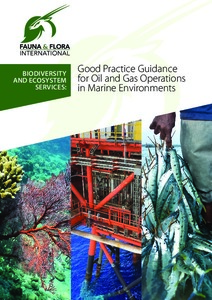Biodiversity and Ecosystem Services: Good Practice Guidance for Oil and Gas Operations in Marine Environments.

View/
Average rating
votes
Date
2017Corporate Author
Fauna and Flora International (FFI)
Status
PublishedPages
181pp.
Metadata
Show full item recordAbstract
Our oceans produce more than half of the oxygen in our atmosphere, as well as absorbing carbon. Over
three billion people depend on marine resources for food, and the coastal environment supports the
livelihoods of more than 200 million people. Marine habitats make a vital contribution to biodiversity
and ecosystem services, but are facing growing threats from pollution and infrastructure development.
As energy demands rise, oil and gas companies are focusing increasingly on offshore reserves, placing
additional pressure on the marine environment.
Offshore oil and gas developments and their effects on marine biodiversity and ecosystem services
are, quite rightly, subject to increasing scrutiny at local, national and international levels, with the result
that reputational, operational and financial risk are a growing concern for the oil and gas industry. Until
now, however, guidelines on how to apply, monitor and enable industry standards and policy have
been conspicuously lac.....
Resource URL
www.fauna-flora.orgPublisher
Fauna and Flora (FFI)Cambridge UK
Document Language
enSustainable Development Goals (SDG)
14.114.2
Best Practice Type
Best PracticeGuide
Citation
Fauna & Flora International (FFI) (2017) Biodiversity and Ecosystem Services: Good Practice Guidance for Oil and Gas Operations in Marine Environments. Cambridge U.K., Fauna & Flora International (FFI), 181pp. DOI: http://dx.doi.org/10.25607/OBP-501Collections
 Repository of community practices in Ocean Research, Applications and Data/Information Management
Repository of community practices in Ocean Research, Applications and Data/Information Management